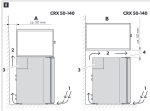Another person here who has enjoyed your posts and videos. I'm downsizing from an old Northern Lite 8-11Q (sold last Fall) and have a Liberty on order that should be ready in Feb/March. Went with the DC compressor fridge and hoping you could share some insights on how that is implemented. I've read that unlike the propane fridges, the compressor fridges can have gaps that allow wind/dirt/bugs to enter into the inside of the camper.
References below
https://www.truckcamperadventure.com/bugs-and-truck-camper-refrigerator-compartments/
https://www.truckcamperadventure.com/saga-of-the-truck-camper-refrigerator-vent/
Since it looks like you've torn into every nook and cranny I'm wondering what you found with the compressor fridge implementation and if there were gaps, as described in the articles above, and if you did anything to mitigate the wind/dust/bug intrusion (and possibly the propane leaking into the camper you mentioned if the wind was just right) that could result from those gaps.
References below
https://www.truckcamperadventure.com/bugs-and-truck-camper-refrigerator-compartments/
https://www.truckcamperadventure.com/saga-of-the-truck-camper-refrigerator-vent/
Since it looks like you've torn into every nook and cranny I'm wondering what you found with the compressor fridge implementation and if there were gaps, as described in the articles above, and if you did anything to mitigate the wind/dust/bug intrusion (and possibly the propane leaking into the camper you mentioned if the wind was just right) that could result from those gaps.



